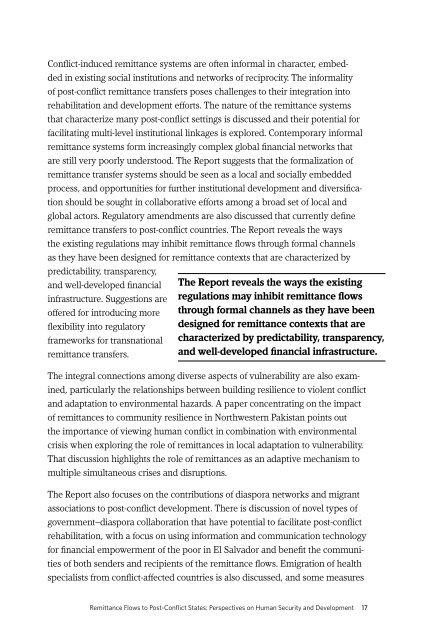Pardee-CFLP-Remittances-TF-Report
Pardee-CFLP-Remittances-TF-Report
Pardee-CFLP-Remittances-TF-Report
You also want an ePaper? Increase the reach of your titles
YUMPU automatically turns print PDFs into web optimized ePapers that Google loves.
Conflict-induced remittance systems are often informal in character, embeddedin existing social institutions and networks of reciprocity. The informalityof post-conflict remittance transfers poses challenges to their integration intorehabilitation and development efforts. The nature of the remittance systemsthat characterize many post-conflict settings is discussed and their potential forfacilitating multi-level institutional linkages is explored. Contemporary informalremittance systems form increasingly complex global financial networks thatare still very poorly understood. The <strong>Report</strong> suggests that the formalization ofremittance transfer systems should be seen as a local and socially embeddedprocess, and opportunities for further institutional development and diversificationshould be sought in collaborative efforts among a broad set of local andglobal actors. Regulatory amendments are also discussed that currently defineremittance transfers to post-conflict countries. The <strong>Report</strong> reveals the waysthe existing regulations may inhibit remittance flows through formal channelsas they have been designed for remittance contexts that are characterized bypredictability, transparency,and well-developed financialinfrastructure. Suggestions areoffered for introducing moreflexibility into regulatoryframeworks for transnationalremittance transfers.The <strong>Report</strong> reveals the ways the existingregulations may inhibit remittance flowsthrough formal channels as they have beendesigned for remittance contexts that arecharacterized by predictability, transparency,and well-developed financial infrastructure.The integral connections among diverse aspects of vulnerability are also examined,particularly the relationships between building resilience to violent conflictand adaptation to environmental hazards. A paper concentrating on the impactof remittances to community resilience in Northwestern Pakistan points outthe importance of viewing human conflict in combination with environmentalcrisis when exploring the role of remittances in local adaptation to vulnerability.That discussion highlights the role of remittances as an adaptive mechanism tomultiple simultaneous crises and disruptions.The <strong>Report</strong> also focuses on the contributions of diaspora networks and migrantassociations to post-conflict development. There is discussion of novel types ofgovernment–diaspora collaboration that have potential to facilitate post-conflictrehabilitation, with a focus on using information and communication technologyfor financial empowerment of the poor in El Salvador and benefit the communitiesof both senders and recipients of the remittance flows. Emigration of healthspecialists from conflict-affected countries is also discussed, and some measuresRemittance Flows to Post-Conflict States: Perspectives on Human Security and Development 17


